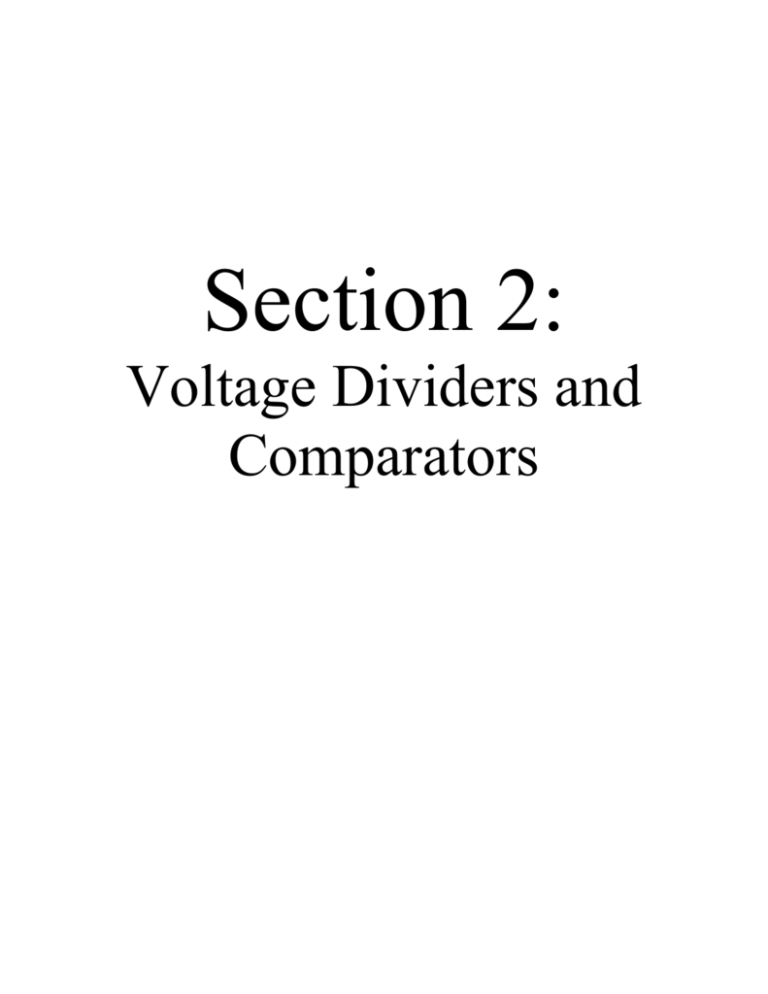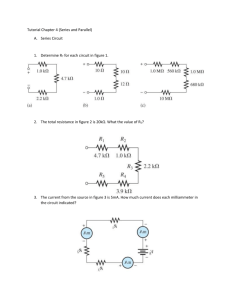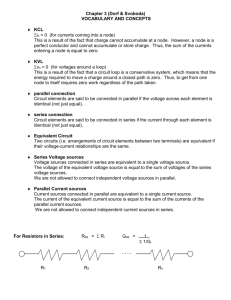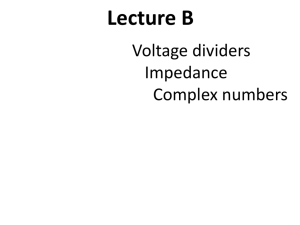docx
advertisement

Section 2: Voltage Dividers and Comparators Voltage Dividers The following is a schematic of a basic voltage divider circuit: The reason that this circuit is called a voltage divider is that the voltage at the node between the two resistors has a value somewhere between the supply voltage and ground. The next diagram shows the same circuit with a voltmeter attached to measure the voltage at this node: To do: Build the voltage divider circuit with R1 = 2.2k and R2 = 4.7k. Connect the voltmeter as shown in the previous diagram to measure the voltage at the center node. In a voltage divider, the voltage dropped across each resistor is proportional to the value of that resistor, and the total voltage dropped across all of the resistors adds up to the supply voltage. Consider the following voltage divider circuit: A 10V source is connected to a voltage divider with an upper resistor of 2 kiloohm and a lower resistor of 3 kiloohm. 4 volts are dropped across the upper resistor and 6 volts are dropped across the lower resistor. The reason is that the ratio 2:3 equals the ratio 4:6, and 4V + 6V = 10V. To do: Build the above circuit, and measure the voltage drops across each resistor. There are no 2 kiloohm or 3 kiloohm resistors; find the closest values you can. In general, the formula for the voltage at the center of a voltage divider of the form of those above is given by the formula: R2 voltage at center of divider = 𝑉𝑠𝑠 × R1 + R2 You can use this formula to help you with the following exercise. Exercise: Imagine a voltage divider that has an upper resistor (R1) of 4.7k, and a supply voltage of 10V. What value of lower resistor would you need to get 6V at the center node? Find a resistor close to the value you found, build the circuit, and see if it works. The voltage at the center of a voltage divider depends on the ratios of the resistors, and on the supply voltage. Consider the following 3 voltage dividers: Even though the resistor values are different in each one, the ratios are the same, so in each case the voltage at the center is 6.3V. From this you can see that if you are designing a voltage divider, you have flexibility in which resistor values you choose. Is it better to choose high values, or low ones? There are disadvantages on both sides of the spectrum. If very low values are chosen, large currents flow through the divider, which loads the power supply. If very high values are chosen, then the center node doesn’t maintain it’s voltage very well under loading. The complete answer is that it depends on the load. In this section, the dividers will eventually be loaded with 741 op amp inputs, which draw very little current. For the purposes of this section, choose values of R1 and R2 such that R1 + R2 lies between 1kΩ and 20kΩ. Exercise: For each supply voltage below, design a voltage divider that will produce the given output voltage. Use the guideline that R1 + R2 should lie between 1kΩ and 20kΩ. Test your circuit by building it, and try to get the output within a margin of ±0.25V. Supply voltage Output voltage 12V 6V 10V 3.5V 12V 7.2V 8V 2.5V Potentiometers: A potentiometer is a variable resistor. There are a number of different types of potentiometers in the lab, and what they look like (roughly) is illustrated in this diagram: The circuit diagram for a potentiometer is as follows: The diagram illustrates well what’s happening inside the component; there is a constant resistance between the two farthest terminals (1 and 3). The middle terminal (2) “moves” between the two end terminals as the potentiometer is adjusted. Every time you turn the potentiometer, the resistance between the center and one end is increased, and the resistance between the center and the other end is decreased. Sometimes where a simple variable resistor is required, one of the end terminals of the potentiometer is unused. In this configuration, the potentiometer is being used as a rheostat. The following is the circuit diagram for a rheostat: The potentiometers in the lab have resistances of 1kΩ or 10kΩ. To do: Find a potentiometer. Measure the resistance between the end terminals (1 and 3). Confirm that it does not change as the device is adjusted. Measure the resistance between the center terminal and one of the end terminals (1 and 2). Confirm that the resistance changes as the device is adjusted. Note the direction it changes with the direction of rotation. Measure the resistance between the center terminal and the other end terminal (2 and 3). Confirm that the resistance changes as the device is adjusted. Note the direction it changes with the direction of rotation (it should be opposite the direction earlier). A potentiometer can be used as an adjustable voltage divider by connecting its end terminals across the supply: The center terminal now acts as the center node. The following diagram shows a voltmeter connected to the circuit measuring the output voltage of this potentiometer: To do: Build the last circuit with the potentiometer and voltmeter. Adjust the potentiometer and observe the voltmeter reading. How high can you go? How low? Photoresistors: A photoresistor is a resistor that changes its value as light is shined on it. The symbol for a photoresistor is a resistor with arrows pointing towards it: To do: Get a photoresistor and connect it to an ohmmeter. Change the amount of light shining on it by doing one or more of the following: change its angle, cover it with a finger, or shine a flashlight on it. Observe the resistance as you do this. Does the resistance go up or down as light exposure is increased? Note its maximum and minimum values. Photoresistors can be used in voltage dividers to create a node that changes in voltage depending on light levels. The following is a possible circuit of this form, along with an attached voltmeter: To do: Build a voltage divider using a photoresistor as one of the resistors. Choose the other resistor a little less than midway between the photoresistor’s minimum and maximum values that you noted in the last part. Connect a voltmeter to the center node and measure the voltage as the light level changes. Does it go up with more light, or down? How could you reverse it? 741 Op Amp The following is a pinout diagram of the 741 Op Amp: The pin labeled “NC” is unconnected and isn’t used. The pins labeled “Offset null” are used for error correction and not used in this section. V+ is connected to supply and V- is connected to “negative supply.” In some circuits this may be a potential lower than ground (perhaps achieved by introducing a second supply), but in this section this pin will be connected to circuit ground. The remaining pins are key ones; pins 2 and 3 are the inverting and non-inverting inputs respectively, and pin 6 is the output. The way the op-amp works is as follows: when the noninverting input (pin 3) is at a higher voltage than the inverting input (pin 2), the output (pin 6) tends to swing high. If the non-inverting input (pin 3) is at a lower voltage than the inverting input (pin 2), the output (pin 6) tends to swing low. The op amp has its own circuit symbol. The symbol is: Pins 1, 5 and 8 are not represented in the circuit symbol. The following is an alternative pinout diagram achieved by superimposing the circuit diagram on the chip: If the output has some connection to one of the inputs, feedback can be used to control the output and keep it at a certain level. Otherwise, the output is either high or low, depending on which voltage is higher; that at the inverting input or that at the non-inverting input. In this usage, the chip is said to be used in saturation mode, the output is digital (either high or low), and the chip is being used as a voltage comparator. This is how it will be used for the rest of this section. The following circuit illustrates the use of the 741 op amp as a voltage comparator: In this circuit, there are two potentiometer voltage dividers, and each is connected to an input of the comparator. The output of the op amp is connected to an LED, and whether the LED lights or not depends on which voltage divider has a higher voltage. To do: Build the above voltage comparator circuit. Find two voltmeters, and connect them so that one is measuring the voltage at node A and the other is measuring the voltage at node B (nodes A and B are labeled in the diagram). Adjust the potentiometers and confirm that the light turns on when node B is at a higher potential than node A, and turns off if the reverse is true. You now have all the skills you need to build a light-controlled circuit. To do: Rebuild the voltage divider with the photoresistor. Connect a voltmeter to the center node, change the light level, and note the maximum and minimum values of the voltage. Now, build a second (non-light sensitive) voltage divider, with a center voltage half way between the max and min voltages of the light-sensitive divider. For example, if the voltage of the light-sensitive divider varies between 0.4V and 5V, make your second divider so that its output is between 2 and 3 volts. You can do this with a potentiometer, but try it with fixed resistors. Connect the centers of the two dividers to the inputs of the op amp, and an LED to the output with a resistor as in the last diagram. Vary the light level on the photoresistor and observe the results. After it’s done, the circuit should look like this: R1 should be chosen so that the voltage at node A varies dramatically with a change in light levels to the photoresistor. R2 and R3 should be chosen so that the voltage at node B is higher than the voltage at A when the photoresistor has low resistance (high light levels), but so that the voltage at node B is higher than that at A when the photoresistor has high resistance (low light levels). End of Section Projects: Go back to section 1, and review how a second LED was added to the output of the 555 by letting the output act as a sink part of the time. Add a second LED to this circuit on that model, so that one LED is on when light levels are high, and another is on when the light level is low. Go back to section 1, and review how an NPN transistor was used to connect the output of the 555 to a light bulb instead of to an LED. Based on this model, modify the circuit so that it powers a light bulb instead of an LED. Replace the light bulb with an electric motor. Does the circuit work as expected?








